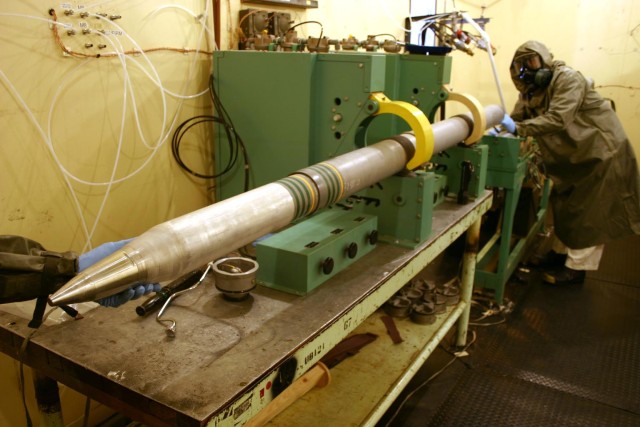The U.S. Army has destroyed more than 70-percent of its stockpiles of chemical weapons -- some dating as far back as to the World War I era -- as part of an elaborate, decades-long process slated to be largely completed by 2012, service officials said.
"As of 26 January, 2010, the U.S. has destroyed a 22,322 tons of the original 31,500 tons," said Greg Mahall, chief of Public Affairs for the U.S. Army Chemical Materials Agency (CMA).
The U.S. arsenal -- which used to include 31,500 tons of chemical weapons such as Sarin, VX and Mustard agents-- is systematically being destroyed at an increased pace, Mahall said.
"It is a tremendous success story. Not only is the U.S doing all it can to meet its international commitments, but more importantly the Chemical Materials Agency is contributing to the national security of the United States in the process. These weapons in the wrong hands can do harm. They are safely and securely storing and destroying them while providing maximum protection to the public and environment," said Carmen Spencer, deputy assistant Secretary of the Army (Elimination of Chemical Weapons).
The Army's Chemical Stockpile Elimination mission, which destroyed more than 3,084 tons of chemical weapons at four facilities during 2009, has been working since the early 90's --- several years before the 1992 drafting of an international Chemical Weapons Convention arms control agreement calling for the destruction of chemical weapons stockpiles and a prohibition on their use and production.
"Production went into a moratorium based on direction from President Nixon in the late 60's," Mahall said.
Article I of the CWC treaty, initially signed in 1993 and now ratified by as many as 188 countries, states in part:
"Each State Party undertakes to destroy chemical weapons it owns or possesses, or that are located in any place under its jurisdiction or control, in accordance with the provisions of this convention."
Recognizing the weapons had become obsolete, the U.S. did not wait for ratification of the CWC Treaty, Mahall said.
"We began destroying our agents at Johnston Atoll [a remote outpost in the central pacific 825 miles southwest of Hawaii] in 1990," said Mahall. "The weapons had a limited tactical use and had been overcome in America's arsenal by other more potent weapons in the nuclear age. The U.S. quit making them, which means stocks on hand sat in storage deteriorating."
The Annual Status Report on the Disposal of Chemical Weapons and Materiel for Fiscal Year 2009 states that $1,548 million was appropriated during the year for chemical agents and munitions destruction.
"CMA remains committed to our storage and destruction mission and remains vigilant to safely completing that mission while protecting the workforce, the public, and the environment," wrote CMA director Conrad F. Whyne in the report.
In addition to the weapons stored on Johnston Atoll in the Pacific, chemical weapons stockpiles were dispersed among eight locations within in the continental U.S. at Army facilities in Anniston, Ala., Pine Bluff, Ark., Tooele, Utah, Umatilla, Ore., Aberdeen, Md., Newport, Ind., Blue Grass, Ky., and Pueblo, Colo.
Destruction of the stockpiles at Blue Grass, Ky., and Pueblo, Colo., now falls under Defense Department management with Army assistance; the remaining sites are currently part of the Army's Chemical Stockpile elimination program.
"All of the nerve agent under CMA destruction has been destroyed with the exception of a small amount of GA (Tabun) in Utah. Comparatively small amounts remain in storage awaiting destruction in Kentucky," said Mahall.
Water and sodium hydroxide-based neutralization methods were used to destroy stockpiles at facilities in Aberdeen, Md., and Newport, Ind. --and incineration technology is employed at other Army locations including Anniston, Umatilla, Tooele, and Pine Bluff, Army officials said.
The stockpiles at Pueblo, Colo., and Blue Grass, Ky., are being destroyed under DoD auspices using water oxidation and neutralization methods; Stockpile destruction at Pueblo, Col., will be finished by 2017 and destruction at Blue Grass, Ky., is slated to be finished by 2021, Spencer said.
Chemical Weapons Incineration
Chemical weapons such as mortars, projectiles or 155mm artillery shells are disassembled and incinerated inside robustly engineered plants adjacent to the storage igloos where the chemical weapons are kept, Mahall said.
"Robotics reverse-assemble these weapons -- unscrewing the nose cone, pulling out the fuse and draining the agent out of the weapon. Then you have two different destruction streams. The hard substances and the liquid agents," said Mahall. "The liquid agents will be stored in a holding tank then sprayed into a furnace called the liquid incinerator. Basically, destruction is a matter of time and temperature. The agents have high, natural BTU quotients and burn quite well. At a temperature of 2,000 degrees Fahrenheit agent will be destroyed completely in a matter of one-to-two seconds."
The bullet, rocket or bomb casings -- the hard substances -- are placed on a conveyor belt, put into a metal furnace and burned for at least 15 minutes at temperatures up to 1,500 degrees Fahrenheit to ensure total destruction of whatever agents might be left, Mahall said.
Given the nature and age of the agents involved, safety and environmental concerns are emphasized and placed at a premium. "A tremendous amount of money has gone in meeting the environmental standards and we have exceeded environmental standards. Our safety record is unparalleled," said Spencer.
The areas where the incineration takes place are built for safety with 22-inch thick concrete walls, Mahall said.
"Plus, the plant has a cascading negative air system where air is pulled in so that if a weapon would release gas due to some of sort of structural failure, any vapors would caught up in the cascading air system and kept in the plant," Mahall said. "Also, carbon air filters would decontaminate the plant air in the event that anything does leak out before that air is released outside engineering controls."


Social Sharing